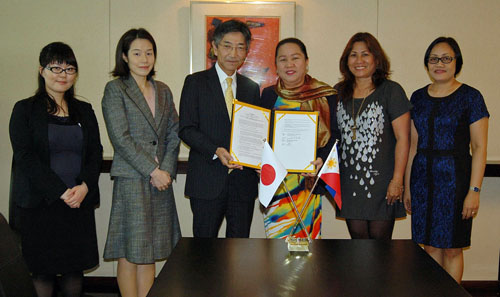Photo shows Japanese Ambassador Kazuhide Ishikawa congratulating Mayor Merlinda Maata after signing the grant contract for “The Project for the Construction of an Outpatient Building of the Rural Health Unit in Vincenzo Sagun, Zamboanga del Sur” on March 26, 2015 at the Embassy of Japan. The ceremony was witnessed by the representatives of the Municipality of Vincenzo Sagun. |
Japanese Ambassador to the Philippines Kazuhide Ishikawa and the Mayor of the Municipality of Vincenzo Sagun, Ms. Merlinda Maata signed the grant contract for "The Project for the Construction of an Outpatient Building of the Rural Health Unit in Vincenzo Sagun, Zamboanga del Sur" on March 26, 2015 at the Embassy of Japan. The total amount is US$ 94,748 (approximately 3.97 million pesos) and is funded through the Grant Assistance for Grassroots Human Security Projects (GGP).
(Project Summary)
Through the GGP project, the LGU of Vincenzo Sagun will procure the necessary medical equipment and furniture for the establishment of an outpatient building connected to the main rural health center. The new building will be used to cater more patients visiting the center. The project will benefit approximately 21,000 residents of the municipality.
Municipality of Vicenzo Sagun has no existing hospital that can cater the needs of its residents. Majority of the patients who cannot afford to pay for health care costs only visit their rural health center which serves as the main health care provider in Vincenzo Sagun. The health center is already old and has a very limited space to accommodate all the patients. Their medical equipments are also outdated already.
(About the Proponent)
Vincenzo Sagun is a coastal municipality, it is situated in the southern most part of the province of Zamboanga del Sur. It has 14 barangays with a total population of 21,139 residents. Vincenzo Sagun is one of the poorest municipalities in the country with an alarming poverty index of 75.82%.
A daily life of the people in the municipality is mostly devoted to farming and fishing. As a coastal municipality, the local fisherfolk greatly depend on the income they get from fishing. The 30,175 hectares of coastal areas serve as their main source of livelihood. One of the municipality’s featured products are the dried fish which are usually exported to the other provinces. However, due to the inconsistency of the volume of catch depending on the season, most of the time, the fisherfolk are left with very small income. To be able to augment their income, and provide more for their families, the residents of the municipality also engage themselves with farming. The municipality has an area of 6,513 hectares of land which is covered by perennial crops specifically with the coconuts that occupies about 79% of the land area. Aside from marketing these crops, the families also consume their harvests for their everyday meals.
(About the GGP)
The Government of Japan, as the top ODA donor for the Philippines, launched the Grant Assistance for Grassroots Human Security Projects in the Philippines in 1989 for the purpose of reducing poverty and helping various communities engaged in grassroots activities. As of present, 504 grassroots projects have been funded by GGP. Japan believes that this project will not only strengthen the friendship between the peoples of Japan and the Philippines but also contribute to further fostering a strategic partnership between Japan and the Philippines toward the future.
Japanese Version
|


